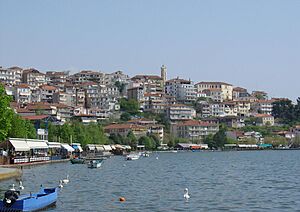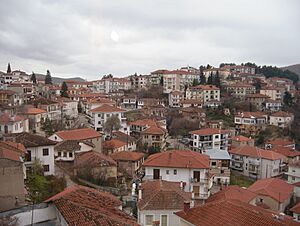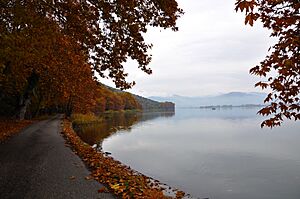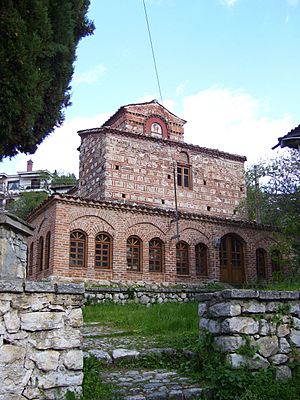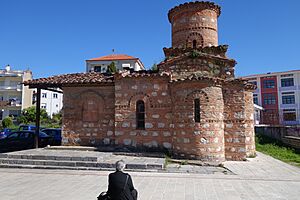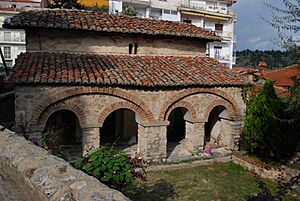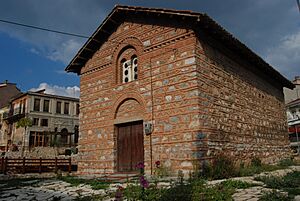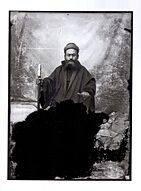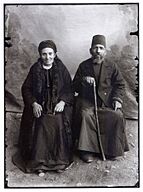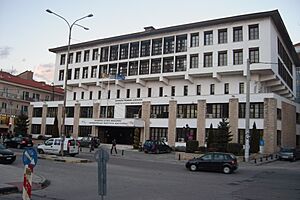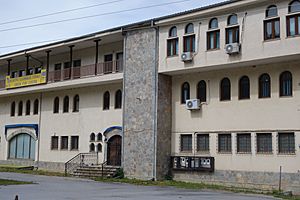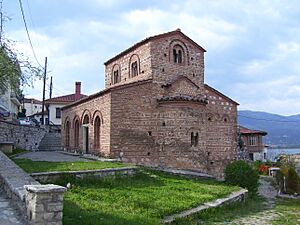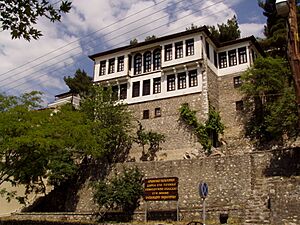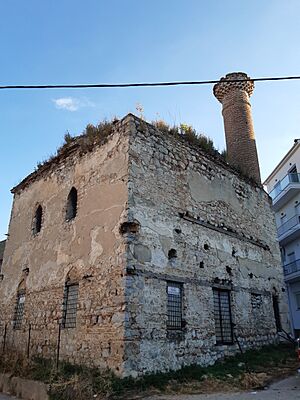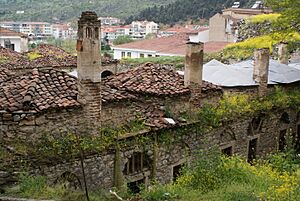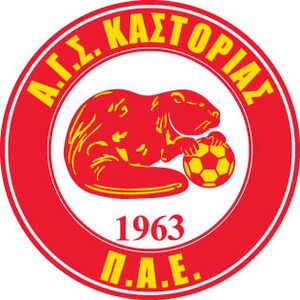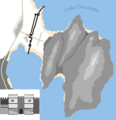Kastoria facts for kids
Quick facts for kids
Kastoria
Καστοριά
|
|
|---|---|

Kastoria and Lake Orestiada.
|
|
| Country | Greece |
| Geographic region | Macedonia |
| Administrative region | Western Macedonia |
| Regional unit | Kastoria |
| Area | |
| • Municipality | 763.3 km2 (294.7 sq mi) |
| • Municipal unit | 57.3 km2 (22.1 sq mi) |
| Elevation | 700 m (2,300 ft) |
| Population
(2021)
|
|
| • Municipality | 33,095 |
| • Municipality density | 43.358/km2 (112.296/sq mi) |
| • Municipal unit | 16,393 |
| • Municipal unit density | 286.09/km2 (741.0/sq mi) |
| Demonym(s) | Kastorian Kastorianos (Greek) |
| Time zone | UTC+2 (EET) |
| • Summer (DST) | UTC+3 (EEST) |
| Postal code |
521 00
|
| Area code(s) | 24670 |
| Vehicle registration | KT |
Kastoria (Greek: Καστοριά, Kastoriá [kastoˈrʝa]) is a city in northern Greece. It is located in the Western Macedonia region. Kastoria is the main city of the Kastoria regional unit. It sits on a piece of land that sticks out into Lake Orestiada. This area is surrounded by limestone mountains. The city is famous for its many old Byzantine churches. It also has beautiful buildings from the Byzantine and Ottoman times. The lake itself is a big attraction, and Kastoria is well-known for its fur clothing industry.
Contents
What's in a Name?
The city was first mentioned in the year 550 AD by a writer named Procopius. He described a city near a lake called Castoria. This city was on an island in the middle of the lake, connected by a narrow path. Even though he called it a city of Thessaly, his description perfectly matches Kastoria.
There are a few ideas about where the name Kastoria comes from. The most popular idea is that it comes from the Greek word κάστορας (kástoras). This word means "beaver". In the past, trading beaver fur from nearby Lake Orestiada was a very important part of the city's economy.
Other ideas suggest the name comes from the Greek word κάστρο (kástro), which means "castle". This word comes from the Latin word castrum. Another theory is that it's named after a mythical hero called Κάστωρ (Kástōr). Sometimes, the name is spelled Castoria, especially in older books. The name was also borrowed into Turkish as Kesriye. In Bulgarian, Macedonian, and Serbian, the city is called Kostur. The Albanian name is Kosturi, and the Aromanian name is Castoria.
City and Area
The municipality of Kastoria was created in 2011. This happened when nine smaller areas, called former municipalities, joined together. These areas then became "municipal units" within the larger Kastoria municipality.
The municipal units that joined were:
- Agia Triada
- Agioi Anargyroi
- Kastoria
- Kastraki
- Kleisoura
- Korestia
- Makednoi
- Mesopotamia
- Vitsi
The whole municipality covers about 763 square kilometers. The main municipal unit of Kastoria itself is about 57 square kilometers. This unit includes the town of Kastoria and smaller villages like Aposkepos, Kefalari, and Chloi.
City Neighborhoods
Kastoria has several distinct neighborhoods:
- Apózari
- Doltsó
- Dailaki (Myloi)
- Doplitsa
- Kato Agora
- Kallithea
- Lyv
Main Streets
Some of the important streets in Kastoria are:
- Palaiologou Street
- Nikis Avenue
- Christopoulou Street
- Kyknon Avenue
- Orestion
- Orestiados
- Megalou Alexandrou
- Kapodistria
- Ifaistou
Weather
Kastoria has a humid subtropical climate. This means it has hot, humid summers and mild winters. Because of the nearby lake, the temperatures in Kastoria are not as extreme as in other parts of Western Macedonia. The lake helps to keep the weather milder.
| Climate data for Kastoria city (623m) | |||||||||||||
|---|---|---|---|---|---|---|---|---|---|---|---|---|---|
| Month | Jan | Feb | Mar | Apr | May | Jun | Jul | Aug | Sep | Oct | Nov | Dec | Year |
| Mean daily maximum °C (°F) | 7.2 (45.0) |
11.8 (53.2) |
14.7 (58.5) |
17.3 (63.1) |
23.3 (73.9) |
27.8 (82.0) |
30.4 (86.7) |
31.3 (88.3) |
26.4 (79.5) |
19.6 (67.3) |
13.9 (57.0) |
9.2 (48.6) |
19.4 (66.9) |
| Mean daily minimum °C (°F) | −1.1 (30.0) |
0.8 (33.4) |
3 (37) |
6 (43) |
10.2 (50.4) |
14.3 (57.7) |
16.9 (62.4) |
16.9 (62.4) |
13.5 (56.3) |
8.6 (47.5) |
5.8 (42.4) |
2.8 (37.0) |
8.1 (46.6) |
| Average precipitation mm (inches) | 50 (2.0) |
54 (2.1) |
61 (2.4) |
79 (3.1) |
81 (3.2) |
48 (1.9) |
40 (1.6) |
31 (1.2) |
46 (1.8) |
66 (2.6) |
65 (2.6) |
40.5 (1.59) |
661.5 (26.09) |
| Source: 2019–2021 averages and precipitation | |||||||||||||
History of Kastoria
Ancient Times
Kastoria is thought to be a very old city. A Roman historian named Livy wrote about a town called Celetrum near a lake around 200 BC. This town surrendered to the Romans during a war. It's possible that Celetrum was located on a hill above where Kastoria is today.
The Roman Emperor Diocletian (who ruled from 284 to 305 AD) founded a town nearby called Diocletianopolis. Later, after this town was destroyed, Emperor Justinian moved it to the promontory where Kastoria is now. He might have renamed it Justinianopolis.
Middle Ages
Kastoria first appears in history during the wars between the Byzantine Empire and the First Bulgarian Empire around the year 1000. The Bulgarians held the city until 1018, when the Byzantine emperor Basil II conquered it.
In 1082, the Normans (from northern Europe) took over Kastoria for a short time. But the Byzantine emperor Alexios I Komnenos soon got it back.
During the 1200s and 1300s, Kastoria was often fought over. It changed hands many times between different powers like the Second Bulgarian Empire, the Despotate of Epirus, and the Nicaean Empire. Under Bulgarian rule, Kastoria had a notable Jewish community.
Later, the city became part of the Serbian Empire under Stephen Dushan in 1342. After Dushan's death, it was ruled by different local leaders. Finally, the Ottoman Empire conquered Kastoria in the mid-1380s.
Ottoman Era
The Ottoman Turks took control of Kastoria around 1385. Records from 1445 show that most people in Kastoria were Christians, with smaller groups of Jews and Muslims. After the Ottomans conquered Constantinople, some Jews from Kastoria were moved there to help repopulate the city.
During Ottoman rule, wealthy Greek merchants in Kastoria supported Greek education. The oldest Greek school in the town was founded in 1614.
In the late 1600s, some people in Kastoria supported the Jewish messianic movement called Sabbateanism. By 1740, Jews from other areas also settled in Kastoria.
In the late Ottoman period, Kastoria was an important center. Jews from Kastoria, who spoke Ladino (a Jewish language), moved to the United States. They formed a "Kastoria Society" there. The Jewish community in Kastoria had a chief rabbi, three Jewish religious schools (yeshivot), and several synagogues.
At the start of the 20th century, the town had a mix of people. There were Greek Christians, Turkish Muslims, Jews, Bulgarian Christians, Albanian Christians, and Roma people. The strong Greek cultural traditions in Kastoria led to a strong Greek national feeling. This made Kastoria a key place for the Greek movement in western Macedonia during this time.
Macedonian Struggle and Balkan Wars
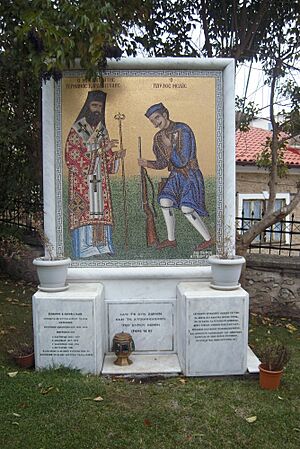
Kastoria played a big role in the Macedonian Struggle (early 1900s). This was a conflict where different groups fought for control of the Macedonia region. Germanos Karavangelis, a Greek Orthodox bishop in Kastoria, was a very important figure. He worked to protect Greek interests and formed early Greek armed groups.
Ottoman rule in Kastoria ended when the Greek Army took the city in the First Balkan War in 1912. In 1913, Kastoria officially became part of Greece.
Between the World Wars
In 1923, after a population exchange between Greece and Turkey, the Muslim people of Kastoria moved to Turkey. Greek refugee families from other areas, like Asia Minor, then settled in Kastoria.
In 1928, there were about 1,000 Jewish people in Kastoria. Some Jewish children from Kastoria went to study in Mandate Palestine.
World War II
During World War II and the Greek Civil War, Kastoria was heavily damaged by fighting.
In World War II, Kastoria and its Jewish population came under Italian control. In 1943, the city's archive was destroyed by fire. Later in 1943, Germany took control of Kastoria. In March 1944, 763 Jewish people from Kastoria were captured. They were sent to the Auschwitz concentration camp and tragically killed. By 1945, only 35 Jewish people remained in Kastoria. This was a 95 percent reduction due to the Holocaust.
The city was later freed by Greek resistance fighters.
Modern Times
After the Greek Civil War, many Greeks from Kastoria moved abroad. In the 1980s, about 25,000 Kastorian Greeks lived in the New York area. Many worked in the fur industry. Another 10,000 settled in Frankfurt, Germany, which became a new center for the fur industry.
The Jewish population in Kastoria became very small after the war. By the late 20th century, the Jewish presence in Kastoria had almost disappeared due to deaths and people moving away. A documentary called Trezoros: The Lost Jews of Kastoria was made about the city's Jewish community.
Economy
Kastoria is a popular place for tourists. It is also a global center for the fur trade. Because of this, it is sometimes called "the city of the fur traders." Tourism and the fur industry are the most important parts of the local economy. The city might even be named after the European beaver (kastóri in Greek), whose fur was once a main product. Today, trading in mink fur is very common. Every year, an international fur show takes place in Kastoria.
The fur industry in Kastoria started in the 1500s. Merchants from Kastoria traveled and traded furs across Europe, including in Germany and Russia. In the 1600s, Kastoria was a major center for the European fur industry. Many wealthy Jewish dealers were involved in this trade. By the late 1700s, Kastoria had a strong Greek business culture.
In Kastoria, the Jewish community was very involved in the fur industry. Jewish merchants worked closely with Greek craftsmen. The city's economy was very successful in the 1800s because both groups worked well together.
Today, Kastoria has more than 300 small and large fur businesses. When Greeks from Kastoria moved to New York in the early 1900s, they helped the fur industry grow there. Many small fur businesses in New York are still owned by Kastorian Greeks.
Other industries in Kastoria include selling local farm products. These include wheat, apples, wine, and fish. The city also has a large shopping center. Kastoria has 16 local radio stations, two TV stations, five daily newspapers, and seven weekly newspapers. The city's airport is called Aristotelis Airport.
Famous Places
Byzantine Churches
Kastoria is an important religious center for the Greek Orthodox Church. It is the home of a metropolitan bishop. Originally, Kastoria had 72 Byzantine and medieval churches. Today, 54 of these churches still stand. Some famous ones include Panagia Koumpelidiki and St Athanasius of Mouzaki. Many of these churches have been restored. They show us a lot about the art and architecture of the Late Byzantine period.
The Museum of Byzantine History is located in Dexamenis Square. It has many examples of Byzantine religious art. The Costume Museum and the Monuments Museum are also in the city.
Doltsó and Apózari Neighborhoods
During the Ottoman era, many different people from across the Balkans came to Kastoria. This led to a diverse community. The city's layout changed, with different groups living in separate neighborhoods. Two old Greek neighborhoods by the lake, "Doltso" and "Apozari," are among the best-preserved traditional parts of the city.
These neighborhoods are known for their many old houses. These include large private mansions and smaller traditional homes. They were built between the 17th and 19th centuries. During this time, the fur trade made many people wealthy. This wealth was used to build beautiful mansions with special architecture and decorations. These neighborhoods, with their churches and old houses, are a rare example of a Byzantine and post-Byzantine town that is still lived in today.
However, these traditional buildings are now at risk. New construction in the city and a lack of care threaten them. In 2014, Doltso and Apozari were put on the "7 Most Endangered list" of Europe's most at-risk historical sites.
Jewish Monuments
In the late 1400s, a synagogue called Aragon was built in Kastoria. Another Aragon synagogue was built in 1830. After World War II, the Aragon synagogue was sold and then torn down. The Jewish cemetery in Kastoria was not cared for after the war. By the 1970s, it was overgrown with plants. Later, the Greek army took over the cemetery land and built military barracks there. Some tombstones were saved, but most were used to build paths and parts of the barracks.
Ottoman Monuments
During the Ottoman era, the Muslim people in Kastoria built many public and private buildings, including mosques. Kastoria had seven mosques in the late Ottoman period. Some mosques were built on the sites of older Christian churches. The Gazi Ervenos Mosque was one of the first built after the Ottoman conquest. After 1912, the Greek army tore down its minaret. In 1926, the rest of the mosque was demolished and replaced with a water tank.
The Kule Mosque was used as a grain warehouse and then a notary office. In 1950, the Kastoria Municipality tore it down. Other mosques, like Prodromou Mosque, Tabahane Mosque, Hasan Kadi Mosque, and Giahli Mosque, were also destroyed. The Gazi Mosque is well-preserved and used by the metropolitan.
The Kursum Mosque, named for its lead roof, was declared a protected building in 1925. Before Muslims left Kastoria, its last imam sold the mosque. Under Greek rule, it has been used as a museum and a storage place for old items. It is the only surviving mosque in Kastoria that is still somewhat preserved. It is currently being restored.
Other Ottoman buildings, like the Bektashi tekke (a religious building) and other Sufi tekkes, were also demolished. Many Muslim burial monuments (turbes) and cemeteries were also destroyed.
Kastoria's Muslims had four primary schools, an elementary school, and a madrassa (a religious school). The Madrassa building was declared a protected monument in 1925. It was used as a storage depot for salt. Today, the building is closed and abandoned, though some restoration has happened. Parts of Kastoria's Ottoman walls are also protected, but some sections were torn down for new buildings.
Modern Changes
After Greece took control, efforts were made to preserve Kastoria's unique architecture. However, after the population exchange in 1923, a new city plan changed the town's layout. While churches were conserved, many other structures like mansions and Muslim buildings were neglected or torn down. The city kept its traditional look until the 1960s, when new construction changed Kastoria significantly.
Education
The University of Western Macedonia has a School of Sciences in Kastoria. This school has two departments: Informatics and Mathematics. The city also has departments for Communication and Digital Media, and Economics.
Local Food
Kastoria has some delicious local dishes:
- Giouvetsi: Meat with pasta in a tomato sauce.
- Garoufa: A soup made with Grivadi fish.
- Pestrofa: Fresh trout.
- Lake fish: You can find carp, tench, catfish, and eel from the lake.
- Sarmades: Meatballs wrapped in pickled cabbage.
- Makálo: Meatballs served with a garlic sauce.
- Kolokythopita: A tasty pumpkin pie.
- Kremmydopita: An onion pie.
- Milk Pie: A sweet dessert.
- Sáliaroi: Another sweet dessert.
Sports
Kastoria FC is the city's football (soccer) team. It was formed in 1963 when three local teams joined together. Their most successful years were in 1974, when they played in Greece's top football division, and in 1979–1980, when they won the Greek Cup. They beat Iraklis FC 5–2 in the final.
Kastoria is also known for rowing. Rowers from Kastoria have competed in the Olympic Games:
- London 2012 Olympic Games: Giannis Christou, Christina Giazitzidou
- Brazil 2016 Olympic Games: Giannis Christou
The city also has a basketball team called Kastoria B.C..
Population
| Year | Town | Municipal unit | Municipality |
|---|---|---|---|
| 1981 | 20,660 | – | – |
| 1991 | 14,775 | – | – |
| 2001 | 14,813 | 16,218 | – |
| 2011 | 13,387 | 16,958 | 35,874 |
| 2021 | 12,548 | 16,393 | 33,095 |
Location
Notable People
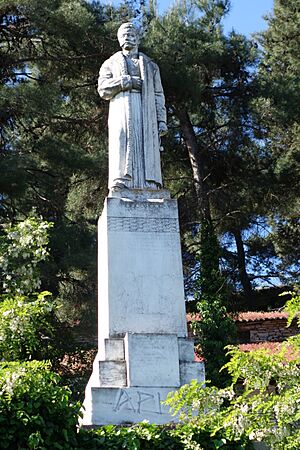
Many interesting people come from Kastoria, including:
- Tobiah ben Eliezer (11th century), a Jewish scholar.
- Kasim Baba, a Sufi holy man from the 15th century.
- Sevastos Leontiadis (1690–1765), an important educator.
- Konstantinos Michail, a scholar.
- Georgios Theocharis (1758–1843), a merchant, revolutionary, and diplomat.
- Athanasios Christopoulos (1772–1847), a famous poet.
- Emmanuel brothers, who worked with the revolutionary Rigas Feraios.
- Vasileios Hatzis, a painter.
- Aristotelis Zachos, an architect.
- Pavlos Argyriadis (1849–1901), a journalist, lawyer, and thinker.
- Argyrios Vouzas (1857–?), a doctor and revolutionary.
- Leonidas Papazoglou, a photographer.
- Şefik Aker (1877–1964), a military officer.
- Nicholas Lambrinides, who founded Skyline Chili, a famous restaurant chain in the USA.
- Andreas Tzimas, a communist politician.
- Lucas Samaras (1936–), a well-known artist.
- Jagnula Kunovska (1943–), a politician, lawyer, and writer.
- Maria Spiropulu (1970–), an experimental physicist.
- Dimitris Diamantidis (1980–), a famous basketball player.
- Ioannis Christou (1983–), a Greek rower.
- Christina Giazitzidou (1989–), an Olympic bronze medalist in rowing.
International Connections
Kastoria has "twin towns" or "sister cities" around the world. These are cities that have special friendly relationships. Kastoria is twinned with:
Images for kids
See also
 In Spanish: Kastoriá para niños
In Spanish: Kastoriá para niños




